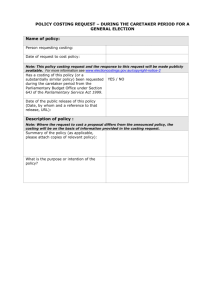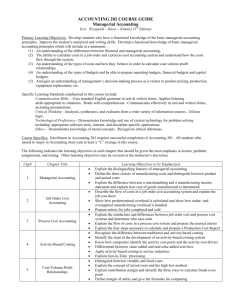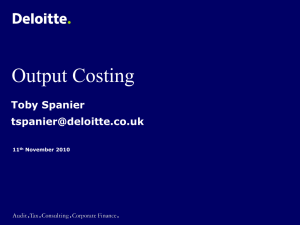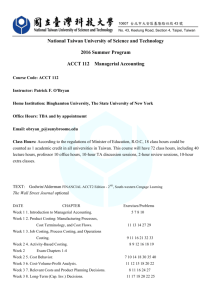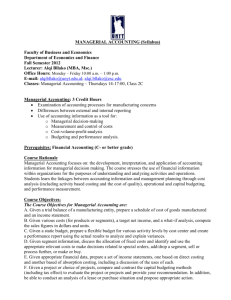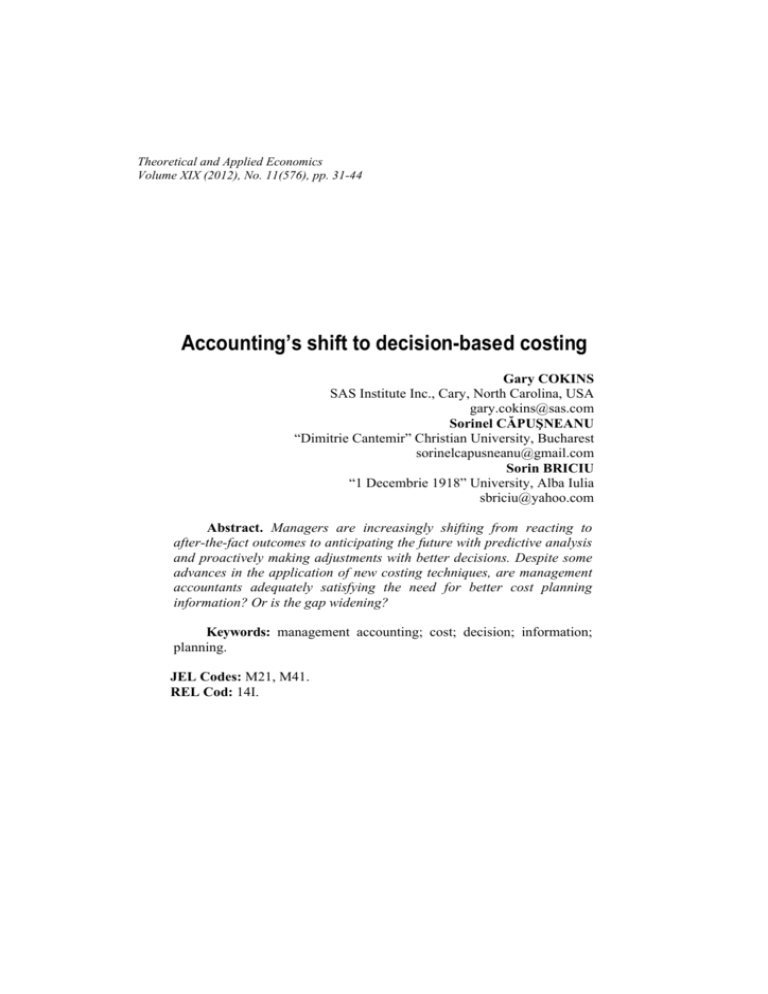
Theoretical and Applied Economics
Volume XIX (2012), No. 11(576), pp. 31-44
Accounting’s shift to decision-based costing
Gary COKINS
SAS Institute Inc., Cary, North Carolina, USA
gary.cokins@sas.com
Sorinel CĂPUŞNEANU
“Dimitrie Cantemir” Christian University, Bucharest
sorinelcapusneanu@gmail.com
Sorin BRICIU
“1 Decembrie 1918” University, Alba Iulia
sbriciu@yahoo.com
Abstract. Managers are increasingly shifting from reacting to
after-the-fact outcomes to anticipating the future with predictive analysis
and proactively making adjustments with better decisions. Despite some
advances in the application of new costing techniques, are management
accountants adequately satisfying the need for better cost planning
information? Or is the gap widening?
Keywords: management accounting; cost; decision; information;
planning.
JEL Codes: M21, M41.
REL Cod: 14I.
Gary Cokins, Sorinel Căpuşneanu, Sorin Briciu
32
1. Introduction
In this century where information plays a pivotal role in the success of a
company, do management accountants provide the necessary information
required by a company's managers?
There is a widening gap between what management accountants report
and what managers and employee teams want and need. This does not mean
that information produced by management accountants is of little value. In the
last few decades, accountants have made significant strides in improving the
utility and accuracy of the costs they calculate and report. The gap is being
caused by a shift in managers’ needs – from just needing to know what things
cost (such as a product cost) and what happened in the past – to a need for
detailed information about what their future costs will be and why.
Despite the accountants advancing a step to catch up with the increasing
needs of managers to make good decisions, the managers have advanced two
steps. Managers already recognize that projections of future outcomes must
recognize which resource capacity expense. In order to understand this
widening gap, and more importantly how accountants can narrow and ideally
close the gap, let’s examine the broad landscape of accounting.
2. The conceptual approaches of management accounting
Management accounting historically evolved as the production of goods
and competitive market economies developed. In the earlier conditions where
the market was only producers satisfying a scarcity of goods demanded by
consumers, the role of management accounting could be summarized as to
provide cost information which permits the manufacturer to adjust prices to
improve profit margins. With time, due to intensified competition, there have
been changes in economic markets. Economic power shifted from producers to
consumers as a result of the emergence of new management models, technical
progress, the Internet etc. These influenced the evolution of accounting systems
with a shift in emphasis to forecasting and planning.
In countries with a developed market economy, management accounting is
considered an information system that integrates business applications with specific techniques and concepts that make up the entity's overall management system.
For Anglo-Saxon economies, for instance, management accounting includes
all of the “valued” information that managers need, and not only the information
on costs. It recognizes that the purpose of management accounting is related to the
capacity of economic resources supplied and not just in their consumption.
In France the management accounting is defined as an “analysis
technique" of the work activities of an entity and its manufactured products to
control internal production conditions through the use of cost information.
Accounting’s shift to decision-based costing
33
The National Council of Accounting in France since 1996 defined the
management accounting thus: "management accounting is designed primarily to
the needs of the enterprise; it constitutes a part of its information system, providing
an economic modeling of the enterprise in order to meet the objectives of
measuring performance and aid in decision making". The process constituted part
of the performance measurement and methods in support of their decisions.
Henri Bouquin (2004) defines the management accounting as: "an
information system which is aimed at helping managers and influence
behaviors through modeling the relationship between resources allocated to
the goals pursued and consumed".
The definition given to management accounting by the National
Association of Accountants (NAA), which is now the Institute of Management
Accountants (IMA, 2008), in the USA is: "the process of identification,
measurement, analysis, collection, processing, transmission and interpretation
of information used by the management of a financial undertaking for planning,
evaluation and monitoring of appropriate and responsible use of its resources".
Management accounting, whose initial goal was calculating costs,
considerably expanded its role by providing information systems for routing
dynamic supply-production-sales receipts with regard to their impact on costs
and outcomes.
Management accounting’s main objectives are: cost calculation,
establishment of results and profitability of products manufactured, work
performed and services rendered, forecast of expenditures and incomes
through the establishment of an internal network of budgets, control of costs
and budgets through the deviations and providing the necessary data to the
grounding decisions on the management of the entity.
In the market economy, formation of prices according to supply and
demand causes producers to pay particular attention to the actual cost of
products compared to the sale price in order to show their effectiveness or
inefficiency of their work and as a result, the level of competitiveness.
3. What is the purpose of management accounting?
Contrary to beliefs that the only purpose of managerial accounting is to
collect, transform and report data, its primary purpose is first and foremost to
influence behavior at all levels – from the desk of the CEO down to each
employee – and it should do so by supporting decisions. A secondary purpose
is to stimulate investigation and discovery by signaling relevant information
(and consequently bringing focus) and generating questions.
The widening gap between what accountants report and what decision
makers need involves the shift from analyzing descriptive historical
34
Gary Cokins, Sorinel Căpuşneanu, Sorin Briciu
information to analyzing predictive information, such as budgets and what-if
scenarios. Obviously, all decisions can only impact the future because the past
is already history. However, there is much that can be learned and leveraged
from historical information. Although accountants are gradually improving the
quality of reported history, decision makers are shifting their view toward
better understanding the future.
This shift is a response to a more overarching shift in executive
management styles – from a command-and-control emphasis that is reactive
(such as scrutinizing cost variance analysis of actual versus planned outcomes)
– to an anticipatory, proactive style where organizational changes and
adjustments, such as staffing levels, can be made before things happen and
before minor problems become big ones.
There is an issue with managerial accounting. There appears to be
competing costing methods (e.g., lean accounting, activity-based costing,
throughput accounting), each with passionate advocates. As a result, there is
some confusion as to which one to use; or alternatively, can two or more
methods co-exist despite calculating different costs for the same item? A
purpose of this article is to discuss the various situations, conditions and types
of decisions that can use different types of cost information.
4. An accounting framework and taxonomy
Figure 1 illustrates the large domain of accounting with three
components: tax accounting, financial accounting, and managerial accounting.
There are two types of data sources displayed at the upper right. The upper
source is from financial transactions and bookkeeping, such as purchases and
payroll. The lower source is non-financial measures such as payroll hours
worked, retail items sold, or gallons of liquid produced.
The financial accounting component is intended for external reporting,
such as for regulatory agencies, banks, stockholders and the investment
community. Financial accounting follows compliance rules aimed at economic
valuation, and as such is typically not adequate or sufficient for decision
making. And the tax accounting component is its own world of legislated rules.
Financial accounting reflects the consumption of resources by their nature,
presents through the synthesis statements the results of the entities as a whole,
without ensuring cost calculation of work, services, products, and does not
allow any analysis of their results.
Whereas financial accounting does not deal with the use of resources, the
transformation after their destination for the resolution of these aspects shall be
involved in management accounting.
Accounting’s shift to decision-based costing
35
Financial accounting lost “the informational war” inside business,
because it is considered to be much “too slow” and irrelevant, seeking of this
cause the development of new channels of information to solve these
disabilities of financial accounting (too slow and way too general). In addition,
financial accounting has created a highly developed mechanism of conventions
that try to present economic situation through the prism of such conventions.
While financial accounting assumes a passive information role,
management accounting in exchange provides tools for the control of
microeconomic processes by allowing its use in managerial decision everyday.
Our area of concern – the management accounting component – can be broken
into three categories: cost accounting, the cost reporting and analysis, and
decision support with cost planning. To oversimplify a distinction between
financial and managerial accounting, financial accounting is about valuation and
managerial accounting is about value creation through good decision making.
Source data capture
(transactions/bookkeeping)
ACCOUNTING
Tax
Accounting
Financial
Accounting
Cost Accounting
Managerial
Accounting
Non-financial data capture
Cost Measurement
Financial Reporting regulatory
compliance
Cost Reporting & Analysis
(Feedback on performance)
- e.g. GAAP, IFRS
- Costs of goods sold
- Inventory valuation
The Domain of Costing
- Spending vs. budget variance
analysis
- Profitability reporting
- Process analysis (e.g. lean,
benchmarking, COQ)
- Performance measures
- Learning corrective actions
Decision Support\
Cost Planning
- Fully absorbed & incremental pricing
- Driver-based budgeting & rolling
financial forecasts
- What-if analysis
- Product, channel & customer
rationalization
- Outsourcing & make vs. buy analysis
Future
History
Low value-add
Modest value-add
High value-add
Source: Copyright 2011. Gary Cokins (at www.garycokins.com. All rights reserved.
Figure 1. The managerial accounting component
Gary Cokins, Sorinel Căpuşneanu, Sorin Briciu
36
The managerial accounting component in Figure 1 is comprised of three
parts that are all recipients of inputs from the “Cost Measurement” procedure of
transforming incurred expenses (or their obligations) into calculated costs:
Cost accounting represents the assignment of expenses into outputs
such as the cost of goods sold and the value of inventories. This box
primarily provides external reporting to comply with regulatory
agencies.
Cost reporting and analysis represents the insights, inferences, and
analysis of what has already taken place in the business in order to
track performance.
Decision support with cost planning involves decision making and
taking. It also represents using the historical cost reporting information
in combination with other economic information, including forecasts
and planned changes (e.g., processes, products, services, channels) in
order to make the types of decisions that lead to a financially
successful future.
It will be apparent that the key differentiator between cost accounting and
the other two uses of “cost measurement” is that cost accounting is deeply
constrained by regulatory practices and describing the past in accordance with
principles of financial accounting. The other two categories offer diagnostic
support to interpret, and draw inferences from respectively what has already
taken place, and what can happen in the future. Cost reporting and analysis is
about explanation. Decision support with cost planning is about possibilities.
The message at the bottom of the diagram is the value, utility and
usefulness of the information increases, arguably at an exponential rate, from
the left-side to the right-side of the diagram.
5. What? So what? Then what?
Figure 1 also illustrates that the degree of value-adding information for
decision making increases from left to right. The cost accounting data
establishes a foundation; it is of low value for decision making. The cost
reporting for analysis information converts cost measurement data into a
context. It is useful for managers and employee teams to clearly observe
outcomes with transparency that may have never been seen before, or is
dramatically different from their existing beliefs derived from their firm’s less
mature cost measurement method. Cost reporting displays the reality of what
has happened, and provides answers to “What?” That is, what did things cost
last period?
Accounting’s shift to decision-based costing
37
However, an obvious follow-up question should be “So what?” That is,
based on any questionable or bothersome observations, is there merit to making
changes and interventions? How relevant to improving performance is the
outcome we are seeing? But this leads to the more critical, and relatively higher
value-added need to propose actions – to make and take decisions – surfaced
from cost planning. This is the “Then what?” question; for example, what
change can be made or action taken (such as a distributor altering its
distribution routes), and what is the ultimate impact? Of course, changes will
lead to multiple effects on service levels, quality and delivery times, but the
economic effect of profits and costs should also be considered. And this gets to
the heart of the widening gap between accountants and decision makers that use
accounting data. To close the gap, accountants must change their mindset from
managerial accounting to managerial economics – nicknamed here as
“decision-based costing.”
There is a catch. When the Cost Reporting and Analysis component shifts
rightward to the Decision Support with Cost Planning box in Figure 1, then
analysis shifts to the realm of decision support via economic analysis. For
example, one needs to understand the impact that changes have on future
expenses. Therefore, the focus now shifts to resources and their capacities. This
involves classifying the behavior of resource expenses as fixed, semi-fixed,
variable, etc. with changes in service offerings, volumes, mix, processes and
the like – which gets tricky. A key concept is this: The “adjustability of
capacity” of any individual resource expense depends on both the planning
horizon and the ease or difficulty of adjusting the individual resource’s capacity
(i.e., its stickability). This wanders into the messy area of marginal cost
analysis that textbooks oversimplify, but is complicated to accurately calculate
in the real world.
Figure 2 illustrates how a firm’s view of its profit and expense structure
changes as analysis shifts from the historical cost reporting view to a predictive
cost planning view. The latter is the context from which decisions are
considered and evaluated.
Gary Cokins, Sorinel Căpuşneanu, Sorin Briciu
38
Descriptive
Predictive
Past
Now
unused
Future
sunk
unused
Traceable
to products,
channels,
customers,
sustaining
used
Fixed
(unavoidable)
Variable
(adjustable
capacity,
avoidable)
Source: Copyright 2011. Gary Cokins (at www.garycokins.com). All rights reserved.
Figure 2. Accounting treatments and behavior of capacity (expenses)
In the figure’s left-hand side during the historical time period, the
resource expenses were incurred. The capacity of these expenses were incurred
for were supplied, and then they were either (1) unused as idle or protective
capacity; or (2) they were used to make products, deliver customer services or
to internally sustain the organization. This is the cost reporting and analysis
component from Figure 1 that calculates output costs. The money was spent,
and costing answers where it was used. This is the descriptive view of costs.
Accountants refer to this as full absorption costing when all the expenses for a
past time period are traced to outputs. It traces expenses (and hopefully does
not allocate expenses on causal-insensitive broad averages) to measure which
outputs uniquely consumed the resources, including individual output costs.
Full absorption costing uses direct costing methods, which are relatively easy to
apply, and supplements the reporting with activity-based costing techniques for
the indirect and shared expenses – which are trickier to model, calculate and
report.
In contrast, Figure 2’s right-hand side is the predictive view of costs – the
decision support with cost planning component from Figure 1. In the future, the
capacity levels and types of resources can be adjusted. Capacity only exists as a
resource, not as a process or work activity. The classification of an expense as
fixed, semi-fixed or variable depends on the planning horizon. The diagonal
line reveals that, in the very short term, most expenses are not easily changed;
Accounting’s shift to decision-based costing
39
hence, they are classified as fixed. As the time horizon extends into the future,
then capacity becomes adjustable. For example, assets can be leased, not
purchased; and future workers can be contracted from a temporary employment
agency, not hired as full-time employees. Therefore, these expenses are
classified as variable.
In the Predictive view of Figure 2, changes in demand – such as the
volume and mix of products and services ordered from customers – will drive
the consumption of processes (and the work activities that belong to them). In
turn, this will determine what level of both fixed and variable resource
expenses are needed to supply capacity for future use. For purchased assets,
such as retail store display shelves or expensive equipment, these costs are
classified as sunk costs. Their full capacity and associated expense were
acquired when an executive authorized and signed their name to the purchase
order for the vendor or contractor. Some idle capacity (such as staffing a
customer call center) is typically planned for. This deliberately planned idle
capacity is intended to meet temporary demand surges, or as an insurance
buffer for the uncertainty of the demand forecast. Its cost is justified by
offsetting potential lost revenues from unacceptable, low service levels to
customers.
Since decisions only affect the future, the predictive view is the basis for
analysis and evaluation. The predictive view applies techniques like what-if
analysis and simulations. These projections are based on forecasts and
consumption rates. However, consumption rates are ideally derived as
calibrated rates from the historical, descriptive view – where the rate of
operational work typically remains constant until productivity and process
improvements affect them. These rates are for both direct expenses and rates
calibrated by an activity-based costing model for the indirect and shared
expenses. And when improvements or process changes occur, the calibrated
historical consumption rates can be adjusted up or down from the valid baseline
measure that is already being experienced. Accountants refer to these
projections as marginal expense analysis. For example, as future incremental
demands change from the existing, near-term baseline operations, how is the
supply for capacity affected?
Various costing techniques, to be discussed following the next section,
rely on these costing principles.
Gary Cokins, Sorinel Căpuşneanu, Sorin Briciu
40
6. What types of decisions are made with managerial accounting
information?
There are hundreds of pages on managerial and cost accounting within
university textbooks. Let’s try to distill all those pages to a few paragraphs.
Planning and
budgeting
Rationalization
Past
Capital expense
justification
Make versus
buy and general
outsourcing
decisions
Process and
productivity
improvement
Present
Descriptive
Future
Predictive
Figure 3. Decision-making categories for applying managerial accounting
The broad decision-making categories (Figure 3) for applying managerial
accounting are:
1. Rationalization – Which products, stock keeping units (SKUs),
services, channels, routes, customers, etc. are best to retain or improve? And,
which are not and should potentially be abandoned or terminated?
Historical and descriptive costing (the left side of Figure 2) can be
adequate to answer these questions. In part, this explains the growing
popularity in applying activity-based cost principles to supplement traditional
direct costing. There is much diversity and variation in routes, channels,
customers, etc. that cause a relative increase in an organization’s indirect and
shared expenses to manage the resulting complexity. IT expenses are a growing
one. Having the direct and indirect costs become a relevant starting point lets
you know what the variations cost. This answers the “What?” question. It is
difficult, arguably impossible, to answer the subsequent “So what?” question
without having the facts. Otherwise, conclusions are based on gut feel,
intuition, misleading information or politics.
2. Planning and budgeting – Based on forecasts of future demand volume
and mix for types of services or products, combined with assumptions of other
proposed changes, how much will it cost to match demand with our supplied
resources (e.g., workforce staffing levels)?
When questions like these and many more like them are asked, one needs
more than a crystal ball to answer them. This is where the predictive view of
costing (the right side of Figure 2) fits in. This is arguably the sweet spot of
costing. On an annual cycle, this is the budgeting process. However, executives
Accounting’s shift to decision-based costing
41
are increasingly demanding rolling financial forecasts at shorter intervals. This
demand is partially due to the fact that the annual budget can quickly become
obsolete and future period assumptions, especially sales forecasts, become
more certain. At its core, this costing sweet spot is about resource capacity
planning – the ability to convert and reflect physical operational events into the
language of money – expenses and costs.
3. Capital expense justification – Is the return on investment (ROI) of a
proposed asset purchase, such as equipment or an information system,
justified?
If we purchase equipment, technology or a system, will the financial
benefits justify the investment? A question like this involves what
microeconomics refers to as “capital budgeting.” Capital budgeting analysis
typically involves comparing a baseline, reflecting business as usual, with an
alternative scenario that includes spending on (i.e., investing in) an asset where
the expected benefits will continue well beyond a year’s duration. An example
would be investing in an automated warehouse to replace manual, pick-andpack labor. Some refer to the associated investment justification analysis as
“same as, except for” or comparing the as-is state with the to-be state. A
distinction of capital budgeting is it involves discounted cash flow (DCF)
equations. DCF equations reflect the net present value (NPV) of money,
incorporating the time that it would take for that same money to earn income at
some rate if it were applied elsewhere (e.g., a bank certificate of deposit). The
rate is often called the organization’s cost of capital.
4. Make versus buy and general outsourcing decisions – Should we
continue to do it ourselves or contract with a third party? If we choose to have a
third party make our product or deliver our service instead of ourselves –
basically outsourcing – (or vice versa by bringing in-house) then afterward,
how much of our expenses remain and how much will we remove (or add)?
This type of decision is similar to the logic and math of capital budgeting. The
same description of the capital budgeting method applies – measuring “same
as, except for” incremental changes. Ideally, activity-based costing techniques
should be applied because the primary variable is the work activities that the
third party contractor will now perform, which replace the current in-house
work. Since cost is not the only variable that shifts, a service-level agreement
with the contactor should be a standard practice.
5. Process and productivity improvement – What can be changed? How
to identify opportunities? How to compare and differentiate high-impact
opportunities from nominal ones? Some organization’s operations functions are
focusing on reducing costs and future cost avoidance (Strategic profitable
revenue enhancement is addressed with managerial accounting for
42
Gary Cokins, Sorinel Căpuşneanu, Sorin Briciu
rationalization). These operations functions are tasked with productivity
improvement challenges, and they are less interested in understanding strategic
profitability analysis – which of our priced products and services makes or
loses money – and more on streamlining processes, reducing waste and lowvalue-added work activities, and increasing asset utilization. This is the area of
Six Sigma quality initiatives, lean management principles and just-in-time (JIT)
scheduling techniques. Examples of these types of costs are:
Unit costs of outputs and benchmarking.
Target costing.
Cost of quality (COQ).
Value-adding attributes (such as non-value added vs. value-added).
Time-driven activity-based costing (TDABC).
Resource consumption accounting (RCA).
German cost accounting (Grenzplankostenrechnung [GPK]).
Accounting for a lean management environment (also Kaizen costing).
Theory of constraint’s throughput accounting.
The term “cost estimating” is a general one. It applies in all of the
decision-making categories above. One might conclude that the first category,
rationalization, focuses only on historical costs and thus does not require cost
estimates. However, the impact on resource expenses from adding or dropping
various work-consuming outputs also require cost estimates to validate the
merit of a proposed rationalization decision.
7. Managerial decision and the role of management accountant
in making decision
Managerial decision must rely on relevant costs, recognizable by their
forecast features that include hidden costs, social costs and external costs.
Because decisions aimed at future action management requires detailed
information on future costs, some of these are not included in the data
collection system of managerial accounting.
Management accountant must take into consideration only those
predictions or estimates of the costs that is relevant to decision making.
Relevant making decision information is data on costs, revenue and future
resource consumption which are different for each analyzed alternative. In
general, managers follow a making decision model to choose the direction of
action such as: obtaining information; making forecasts; choosing an
alternative; implementation of the decision; performance evaluation.
In making decision, the role of management accountant is to provide
accurate, timely, and in useful form information. In other words, the
Accounting’s shift to decision-based costing
43
management accountant shall discharge to collect relevant information and to
report them in a manner relevant to management. There are many general
techniques of making decision, which helps management accountants to
generate this information and related reports, such as: Activity-Based Costing,
Direct Costing, marginal and incremental expense analysis, etc. Each of these
techniques offers specific reporting format and applies information relevant to a
specific decision in the making decision process.
The role of management accountant is to provide management the
necessary information for making decision and to reflect both the effects of the
risk in conditions of uncertainty, and the most likely outcomes (results). In this
context, decision makers require the types of information considered relevant
for assessing decisional alternatives, but they should not be "overloaded" with a
very large volume of data. The cost data that remains the same without being
impacted for all alternatives are not relevant (Needles et al., 2000). The role of
the management accountant is to collaborate with the managers, analyzing and
presenting information in a particular format and helping them to finalize their
decisions.
8. Concluding remarks
In our introduction, we described the purpose of this article as “to discuss
the various situations, conditions and types of decisions that can use different
types of cost information.” Confusion can arise because some of the methods
calculate and report different costs that are not just variations in cost accuracy,
but are also different costs altogether.
For example, the method of accounting for a lean environment violates
the accounting principle of causality. This raises the question, “Is lean
accounting a viable replacement for, complement to, and/or supplement for
current and evolving management accounting approaches, such as activitybased costing?” Another way of asking this question is “Should there be two or
more different, coexisting cost reporting methods that report dissimilar
numbers?” For example, one tactical costing method is used for operations and
making short-term decisions; another strategic costing method (for planning,
marketing, pricing and sales analysts to evaluate profit margins) is used for
longer-term decisions.
There will be debates, but eventually some form of consensus will
triumph within an organization. The underlying arguments may be due to the
inappropriate usage of standard costing information – and the potential
inappropriate actions that may result. But there may be a deeper problem: Cost
accounting system data is not the same thing as cost information that should be
44
Gary Cokins, Sorinel Căpuşneanu, Sorin Briciu
used for decision making. The majority of value from cost information for
decision making is not in historical reports – the descriptive view. Its primary
value is in planning the future (such as product and customer rationalization),
marginal cost analysis for one-off decisions, or trade-off analysis between two
or more alternatives.
Therefore, key tests for deciding which costing method to use should be:
How does it handle economic projections? Can it accommodate classifying
resource expenses as variable, semi-variable, fixed, or as unavoidable or
avoidable (i.e., allowing for capacity adjustment decisions)? Does it isolate
unused/idle capacity expenses?
The good news is that organizations are challenging traditional
accounting. So, in the end, any accounting treatments that yield better decision
making should prevail. The coexistence of two or more costing approaches may
cause confusion over which one reports the correct cost. But that is a different
problem. What matters is that organizations are seeking better ways to apply
managerial accounting techniques to make better decisions.
References
Blocher, E., Chen, K., Cokins, G., Lin, T. (2004). Cases and Readings in Strategic Cost
Management for use with Cost Management: A Strategic Emphasis, McGraw-Hill/Irwin
Publishing House, ISBN-10: 0072835699, ISBN-13: 9780072835694
Blocher, E., Stout, D., Cokins, G., Chen, K. (2006). Study Guide to accompany Cost
Management, McGraw-Hill Publishing House, ISBN-10:0073128171
Blocher, E., Stout, D., Cokins, G. (2012). Cost Management: A Strategic Emphasis, 6th Edition,
McGraw-Hill Publishing House
Bouquin, H., (2004), Management accounting, TipoMoldova Publishing House, Iaşi, p. 42
Briciu, S., Căpuşneanu S., Rof L.M., Topor D. (2010). Accounting and management control.
Tools for performance evaluation entity, Aeternitas Publishing House, Alba Iulia
Cokins, G. (2012). Strategic Business Management: From Planning to Performance (ISBN
978-1-93735-081-9), AICPA
Cokins, G., Căpuşneanu, S., Barbu, C.M. (2011). Decisions based on synthesis documents
information of the ABC (Activity-Based Costing) method, International Journal of
Accounting and Financial Reporting, Vol. 1, No. 1, pp. 112-132
Institute of Management Accountants (2008). Statements on Management Accounting, Practice
of Management Accounting
Needles, Jr., B.E., Anderson, H.R., Caldwell, J.C. (2000). Basic principles of accounting,
Leviţchi, R. translation, ARC Publishing House, Chişinău, p. 1132
Stenzel, J., Cokins, G., Schubert, K.D. (2010). CIO Best Practices: Enabling Strategic Value
with Information Technology (Wiley and SAS Business Series), Wiley Publishing House,
ISBN-10: 0470635401, ISBN-13: 9780470635407
http://bigfatfinanceblog.com/2010/02/01/the-shift-to-predictive-accounting/
http://blogs.sas.com/content/cokins

